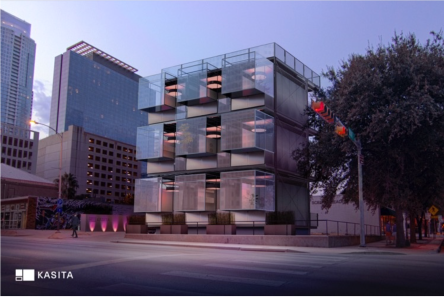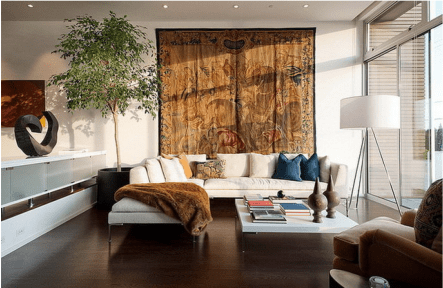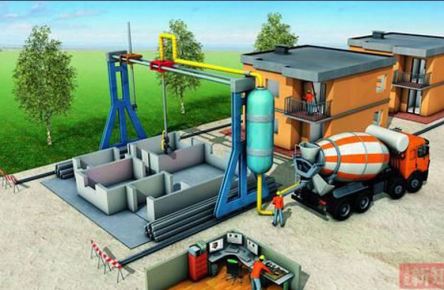Back in 2014, we were excited about the giant 3D printer USC Professor Behrokh Khoshnevis had designed with funding from NASA and the Cal-Earth Institute. The robot was able to build a 2,500-square-foot home in just 24 hours. The process was then known as Contour Crafting and was barely in the research stage. Fast forward to today, the big machine has progressed and seems to have the power to aid the pressing homelessness issue. Currently, the world lacks homes for more than one billion people, according to a report by the World Resources Institute Ross Center for Sustainable Cities. Some areas are in more distress than others, such as El Salvador, where to build a house it tricky because of the land’s vulnerability to earthquakes, flooding and volcanic eruptions. Yet, San Francisco-based housing charity New Story built more than 850 homes in El Salvador, Mexico and Bolivia in the past several years. Those homes costed $6,500 each and each of them took more than two weeks to build. The slow process spurred the company to search for better ways to build. That’s how they came in contact with ICON, an Austin-based construction tech company, to create a 3D printer that can build a 600 to 800-square-foot house in 12 to 24 hours for as little as $4,000. This printer, called Vulcan, was unveiled at SXSW along with a 3D printed house, built to U.S. standards, that’s in an Austin, Texas backyard. The model in Austin has a bedroom, living room, bathroom and a curved porch and the ‘ink’ used in its development is in fact cement, which the company claims, will help normalize the process for potential tenants that wish to know more about the sturdiness of the structure. The machine is designed to...
Tiny, Tiny House
Modern and Stackable
Economic crises and housing shortages have inspired many architects and engineers. Their desire to solve modern housing dilemmas has resulted in several affordable, efficient, and accessible units that change the way that we see multifamily housing. Below are two recent example of space-savvy and cost-effective housing. They could promote big changes in the multifamily marketplace. Kasita He started off by living in a dumpster. Apparently, that’s a great place to seek revelation. Dr. Jeff Wilson, a professor at Huston-Tillotson University in Austin lived in a 33-square-foot dumpster for a year. The experience brought him a sense of balance, flexibility, and simplicity that he feels the need to share with others. Dr. Wilson created Kasita, a tiny house made for urban settings. Traditional tiny houses are solitary and rustic. They’re often set up in the suburbs or rural areas. Owning one—and having a place to put it—requires connections to friends with available lots or enough cash to own a plot of land. Kasita is not this type of tiny house. Each 208-square-foot Kasita is meant to be stacked on “racks,” frames that work a bit like the skeleton of an apartment building. Racks provide hookups for city utilities. By stacking Kasitas vertically, owners can make the most of available space in urban settings. No land ownership is required. Simply a phone call can move owners from a rack in one city to an available rack elsewhere. A big-rig transports the Kasitas to one of 10 racks scheduled to open nationwide. Kasitas are a far cry from the cramped, one-size-fits-all cubes seen in dystopia movies. Inside, Kasitas allow for customization through a unique, wall-mounted tile system: shelves, cabinetry, and countertops can be configured to owners’ specifications. These features are a nice addition to a fully functional...
Fall Staging Tips
Property Management
As a property manager, taking the time to stage your property shows prospects that you’ve got it together. You are prepared, detail-oriented, and organized. You want guests to feel welcomed and comfortable on your property. Such nonverbal marketing turns prospects into tenants. The decorating tips below will make your last-minute fall decorations quick and simple. Interior Decor Your property is likely one of a dozen that a tenant has considered. To make your property memorable, skip the obvious choice of fake pumpkins and scarecrows. Step outside of the average color palette by adding purple and gray to your autumnal arrangements. Use gray as your neutral instead of (or with) black, white, or brown. Purple is a beautiful contrast to fall’s popular reds, oranges, and yellows. Art it Up Wall art is easy to change out with each season. Choosing art with fall colors is a subtle way to celebrate the season even if the subject of the painting does not include fall imagery. Comfy and Cozy Play with the arrangement of throws and quilts. These little touches can instantly transform a nondescript couch into a welcoming retreat. Quilts can also double as wall art. A Savory Smell Scent creates a strong bond to memory. A few carefully placed candles or essential oil diffusers will go a long way towards creating lasting memories for visitors. Pumpkin and apple scents are always a favorite at this time of year. For a more creative touch, consider clove, anise, fennel, and other cooking spices that are common during holiday meals. Exterior Decor Exterior designs can be tough: brown grass, sparse foliage, dry–or worse, soggy–leaves on the ground. In some areas, the best thing that you can do for your property is to keep it tidy: frequently...
A House in 24 Hours
A robot built it
Giant 3D printers, though still in the research stage, may be the perfect candidate to replace built-by-hand homes. USC Professor Behrokh Khoshnevis designed a robot able to build a 2,500-square-foot home in just 24 hours. The process, called Contour Crafting, is in fact scaling up 3D printing to the scale of the building. The big robot’s actions are dictated by a computer program: the construction site is cleared and leveled; the workers lay down two rails a few feet further apart than the building’s width and a computer-controlled contour crafter takes over from there. A gantry-type crane with a hanging nozzle squirts out concrete and with a components-placing arm travels along the rails. The nozzle lays layers of concrete creating hollow walls, and fills them in with additional concrete. People would only install doors and windows. The animation here gives a pretty good idea of how it would ultimately work. “It’s a CAD/CAM solution,” says Khoshnevis. The buildings are “designed on computer and built by a computer”. This method has proved to produce much stronger structures than traditional building methods. According to Contour Crafting, the tested wall is a 10,000PSI (pounds per square inch) strength compared to the average 3,000PSI of a regular wall. With the Contour Crafting solution the cost of home-owning could be slashed, making it possible for millions more humans – especially in developing countries – to have houses. The first thing that comes to mind is the opportunity to build emergency and replacement housing in disaster relief areas, such as recovery from typhoons and hurricanes. It could also be used to build high-quality shelter for those living in desperate conditions: at the beginning of the 21st century, there are almost one billion people in need of stable housing around the world....



